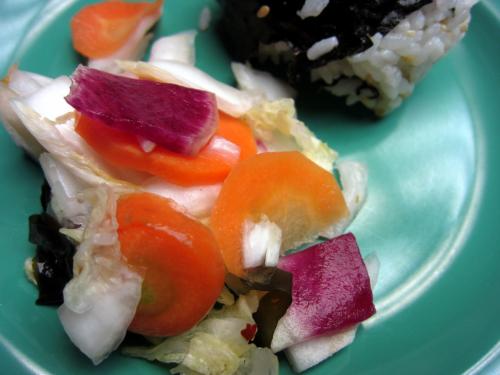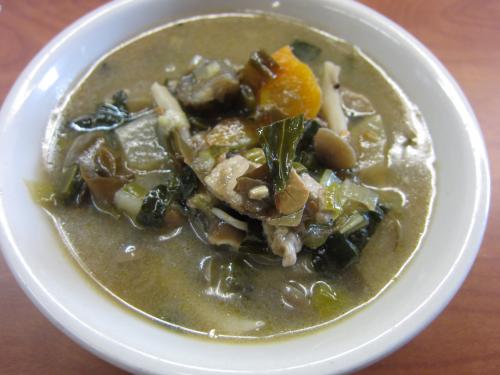Japanese Cooking
The snow was falling thick and hard 15 minutes before Yuko Yanagidaira's Japanese cooking class set was set to start. Vegetables for the recipes were artfully arranged in large bowls, and rice was steaming in the rice cooker.
Class participants were starting to arrive with hair wet with snowflakes and gathering in the kitchen at the McClure Multi-Generational Center, our most recent venue for some of our cooking classes.
With snow swirling like a slowglobe outside the cozy and bright kitchen, we immersed ourselves in Japanese cuisine for an hour and half with Yuko, a native of culturally-rich Sado Island, off the coast of Japan.

Yuko Yanagidaira
I tried to document the recipes as Yuko led us through preparing them, because with Japanese cooking, so much of the experience is in the way the ingredients are beautifully sourced, organized and presented.
Miso Soup
First we prepared the vegetables for miso soup, a pork and vegetarian version. Some of the ingredients we used were (clockwise from top): Lacinato kale, scallions, carrots, daikon, burdock root, and kabocha squash (center):

The roots were chopped and lightly cooked in a combination of a little sesame oil and canola oil:

Yuko prepared the stock for both miso soups the night before by soaking dried shiitake mushrooms and kombu (kelp) together in a mason jar with water. This is second nature to her, a familiar rhythm in her kitchen:

The stock gets simmered with the sauteed vegetables. The miso gets added last. Just for fun, Yuko brought some homemade soybean/brown and white rice miso cultured with koji (which causes the fermentation) for us to sample. Her miso had aged for 2 years (now that's patience)!:

Quick-cooking vegetables like kale and mushrooms are added towards the end for the finished soup (this is the pork miso soup version):
Tsukemono (Quick Pickles)
Tsukemono are quick pickles that are made by seasoning vegetables with salt and pressing them down with a plate. Orange zest, chile flakes, and kombu (kelp) gave these an added flavor. Clockwise from top: Purple-top turnips, watermelon radishes, Satsuma, Napa cabbage, carrots:

...and the finished pickle:

Onigiri (Rice Balls)
These were perhaps the most popular recipe from the class, which Yuko introduced by saying: In Japan, we take this food on picnics all the time... Something like your peanut butter and jelly sandwiches. Yes, except NOTHING like our PB and J's due to how beautiful and fresh these are!
Steamed rice gets tossed with toasted sesame seeds, umeboshi plums, and Wakame sea vegetables:

Then you shape it into balls with your hands and deftly (and not so deftly for some of us) wrap a strip of nori around it. You can make them big or small. Yuko had us make them quite large, which for some reason caused us to giggle!

Here are the recipes for you to try at home:
Japanese Cooking Class Recipes
Pork Miso Soup
Soak overnight:
3-4 dried shiitake mushrooms
3x3" long piece kombu seaweed
6 cups water
***
handful bonito flakes
2 tsp. toasted sesame oil
2 tsp. canola oil
2-3 burdock roots, sliced diagonally
1/2 daikon radish, chopped into bite-size pieces
1 medium carrot, sliced diagonally
1/2 cup pork ribs or tenderloin, sliced thinly (it works best if you freeze pork and thaw it in the refrigerator an hour before slicing it)
1 package beech mushrooms (shimeji), the hard tips removed and divided into small clusters
1 bunch scallions, chopped
1/2 bunch kale or spigarello, chopped
½-inch piece ginger root, grated
3-4 Tbs. miso
Soak dried shiitake and kombu in the water overnight in a soup pot. The next day, slice shiitake and chop the kombu into small pieces and put them back in the pot. Bring broth to a simmer and add bonito flakes.
In a frying pan, heat toasted sesame oil and canola oil and fry burdock, daikon radish, carrot and pork for about five minutes over medium heat. Add it to pot along with beech mushrooms and when the root vegetables are tender (about 15 minutes), add scallions, kale and grated ginger to pot. Simmer for a few minutes until greens are cooked. Remove from heat.
Dissolve miso in some of the broth and return to pot. Allow to steep briefly before serving. Serves 4.
Vegetarian Miso Soup
Soak overnight:
3-4 dried shiitake mushrooms
3x3" long piece kombu seaweed
6 cups water
***
1-2 cups kabocha squash, chopped into small pieces
1/2 yellow onion, sliced
handful mung bean sprouts
1/4-1/2 pound tofu, cubed
2 cups spinach, chopped
Soak dried shiitake and kombu in the water overnight in a soup pot. The next day, slice shiitake and chop the kombu into small pieces and put them back into the soup pot. Bring broth to a simmer and add kabocha squash and onion. Cover.
When the vegetables are tender, add mung bean sprouts and cook for a few minutes. Add tofu and spinach and simmer for a few minutes. Remove from heat.
Dissolve miso in some of the broth and return to pot. Allow to steep briefly before serving. Serves 4.
Tsukemono (Quick Pickles)
1/4 head Chinese or Napa cabbage, chopped
1 medium carrot, sliced diagonally
1/4 daikon radish or 1/2 black radish, chopped
1 purple top turnip, chopped
1 tsp. salt
2 pieces kombu seaweed, cut very thinly with scissors
pinch red hot chili flakes
strip of tangerine orange peel, minced
In a large bowl, mix vegetables and seasonings and "massage" with hands. Put a plate inside the bowl and put a weight on top to press down on the vegetables. Leave it for an hour or more. Squeeze excess liquid and serve. Serves 4.
Onigiri (Rice Balls)
3-4 sushi nori sheets, cut into strips
4 cups cooked short-grain rice (brown or white)
2 Tbs. dried ready-to-use wakame seaweed
2-3 umeboshi/ pickled plums, pitted and torn into pieces
2 Tbs. sesame seeds (black or white), lightly toasted
salt
Cut nori sheets into 8 equally sized, rectangular strips. Put warm rice in a bowl and combine with wakame seaweed, umeboshi plums and sesame seeds.
Wet your hands and sprinkle them with salt to prevent the rice from sticking to them. (Omit this when you are using plastic wrap to form rice balls). Mold a handful of rice into a triangular or round shape. Wrap the rice in nori strips and serve. Serves 4.
Recipes from Yuko Yanagidaira
